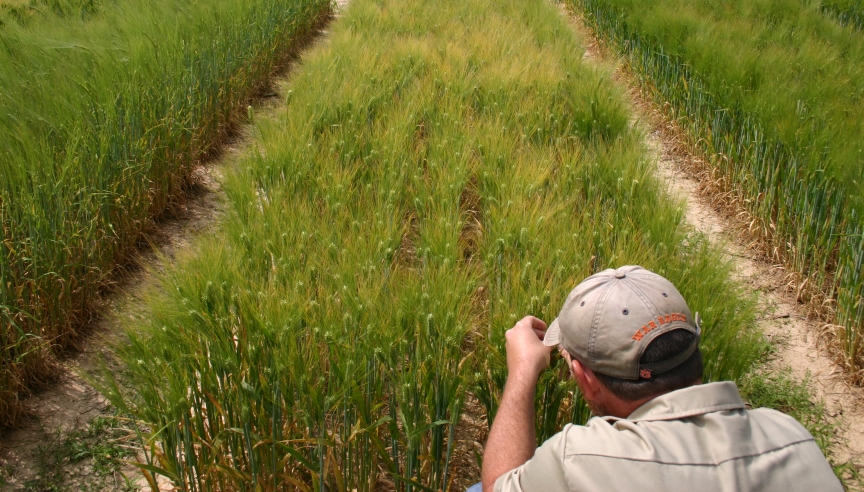
Researchers in Auburn University’s College of Agriculture have embarked on a project to offer production recommendations for farmers in the state who are interested in growing barley and hops.
by PAUL HOLLIS
The growth of the nation’s craft brewing industry continues to soar, with 2015 revenues up by 16 percent, to $23 billion, from 2014. Alabama is part of that growth, but the state’s brewers would like more locally grown malting barley and hops to enhance their products.
That’s why researchers in Auburn University’s College of Agriculture have embarked on a project to offer production recommendations for farmers in the state who are interested in adding potential profit-makers to their crop mix.
Working with neighboring land-grant colleges that have more established barley and hops production programs, Auburn scientists are developing recommendations specific to Alabama growers. At this point, barley is seen as a crop that possibly can be thrown into a more traditional rotation while hops is viewed as more of a specialty crop.
“We’re in the early stages, but there are a lot of niche markets we can explore,” says Julie Howe, associate professor in the Department of Crop, Soil and Environmental Sciences. “There’s great interest in homegrown or ‘grown in Alabama,’ and we’re looking to incorporate an agricultural research component into the state’s brewing industry.”
Everyone in the supply chain has a role to play.
“These are intensive crops, and brewers realize they need to leave agriculture to people who know the most about agriculture,” Howe says.
Any brewery attempting to carve its own niche in the market will want something that sets it apart, and locally grown products give people another reason to buy.
“Every Alabama brewer I have talked with is interested in an all-Alabama or all-Southeast-type product,” Howe says. “They won’t brew all of their beers that way, but it might give them an edge over competitors.”
Howe sees a bright future for the state’s craft brewing industry and for the suppliers who support it.
“The industry has come a long way from 10 or 15 years ago, when it was basically nonexistent,” she says.
The industry’s growth is not because people are drinking more beer but because they’re changing the kinds of beer they are drinking.
“The same increase we’ve seen in craft brewers corresponds with a similar decrease in macro brewers,” says Howe. “Consumers want to drink different-tasting beers, and the market is pushing in that direction. Alabama can be a part of this trend.”
Production challenges
Growing barley and hops is not without its challenges, with both crops requiring intensive management.
“We have started evaluating barley and hops varieties, hoping to find some that may grow especially well in Alabama,” Howe says. “We need to look for ingredients that make the beer taste unique and that are also homegrown products.”
Barley varieties either are two-row or six-row, with six-row having a greater protein and enzyme content. Malters and craft brewers prefer two-row because it has a lower nutrient content, and they don’t need the extra enzymes because they are not using corn or rice to supplement barley. The row number denotes the number of seed per head.
Austin Hagan, plant pathology professor, agrees with Howe that barley will have to be treated as a high-maintenance crop.
“This is not forage wheat, where we’re just throwing it into the field, disking it in, throwing a little nitrogen on it, and hoping for the best,” Hagan says. “It’ll take a high level of management to make good yields and avoid diseases.”
This past season, eight barley trials were planted at four locations throughout the state, and Hagan admits it has been a learning process.
“We’ve learned that barley matures rather quickly and probably will be ready to harvest before wheat,” he says. “I’m accustomed to working with wheat and oats, and they tend to give us a little warning when it’s time for them to dry down.”
At the Sand Mountain Research and Extension Center in northeast Alabama, barley was planted on Dec. 10 last year, which is about a month too late, Hagan says. It should be planted one to two weeks prior to traditional wheat planting dates.
Average yields in states where barley is traditionally grown range from 50 to 90 bushels per acre. Seeding rates are similar to those used in wheat, about 30 to 35 seeds per row foot.
This past growing season, Hagan looked at three commercial lines of malting barley and three breeding lines, along with several forage-type varieties, with Endeavor and Thoroughbred performing best. All varieties were from Mid-Atlantic states, either North Carolina or Virginia.
“We’re always looking for a variety that doesn’t add a lot to the cost of production and isn’t susceptible to a lot of major diseases,” he says. “There are essentially two to three diseases that may be an issue in Alabama, including barley yellow dwarf, rust and net blotch. Scab is a possibility given the right conditions. Other diseases potentially could be an issue, but we haven’t seen them yet. Generally, a fungicide labeled for wheat also can be used on barley.”
Barley producers also will need to control small-grain volunteer plants.
“Plants will germinate late and survive over the summer,” Hagan says. “Controlling these around the field edges will be helpful.”
Crop rotation is another important factor in barley production.
“We probably won’t get into a barley/soybean cropping system,” Hagan says. “We’ll have to find another crop to alternate as a winter cover crop or grain crop in rotation with barley.
“Wheat is not a good alternative because it shares diseases with barley. We might need to look at oats or canola. Deep tillage also may be necessary before planting barley in high-risk situations.”
While the majority of hops are grown in the Pacific Northwest, they can be grown in Alabama, under the proper conditions and management, says Kassie Conner, an Extension plant pathologist. They are long-lived perennials—10 to 15 years—requiring lengthy periods of daylight to produce cones.
Hops add aromatic and bittering qualities to the brew process. They can reach a maximum height of 15 to 25 feet and are grown on? trellises.
Conner says quality is important in hops production. Hops typically are rejected if they have suffered from wind and harvest damage, drying imperfections or other defects caused by diseases and insect pests. Her research had shown that the Cascade, Centennial, Chinook, Nugget and Columbus varieties grow well in the Alabama.
Growing for the market
While barley and hops require more intensive management than some traditional crops, there’s money to be made. The price premiums may just be worth the effort, says Preston Prewett, owner of Old South Malt House in Sylvan Springs, west of Birmingham, and a buyer and broker for barley, wheat and rye.
“Barley pricing will depend on several factors,” Prewett says. “Will it be cleaned, can you store it at your facility, do you have access to seed cleaners, delivery options, seed purchase? All of these things have to be worked out on an individual farmer basis.”
Feed barley currently is sold at between $3 and $4 per bushel, while malting barley can bring as much as $15 per bushel, Prewett says.
“If I had to write a contract now for malting barley
now, it would be for around $8.50 per bushel,” he says. “This is a new market, and I’m trying to encourage people to grow. If it’s premium quality, you’ll get even more.”
Not all of a grower’s crop, however, will reach malting barley standards, Prewett says.
“Sixty percent of it might, but we’ll have to find an alternate market for the other 40 percent,” he says. “I’ve never seen a grower get 100 percent of their crop to malting barley standards.”
Jason Wilson, Auburn University alumnus and founder of Back Forty Beer Co. in Gadsden, has been an integral part of the craft brewing industry’s growth in Alabama. Back Forty distributes its products throughout the Southeast, Canada, China, South Korea and parts of the Caribbean.
“When Back Forty began in 2008, there were 1,200 breweries in the United States,” Wilson says. “Today, there are 4,400, with another 2,000 in the planning stage. The overwhelming majority of those 6,000 breweries are producing 1,000 barrels or less. They’re not mass-producing beer.”
So, what distinguishes a craft brewer from a large macro brewery? Wilson says craft brewers add extra ingredients to their products, not to lower their costs but solely to enhance flavor, while macro breweries do so to drastically cut their production expenses.
Wilson acknowledges there are challenges to growing hops and barley in Alabama, but he sees a burgeoning market and premium prices for producers of high-quality crops.
“With the explosion of craft beer in America, some hop varieties are selling for $15 to $20 per pound,” he says. “Our yields may never be like those of other states, but they don’t have to be. They’re very labor-intensive to grow, but brewers clamor over the latest, hottest hops varieties. Yields will be very low in the Deep South, but profit margins can be through the roof.”





